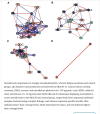wigglethemouse
Senior Member (Voting Rights)
Could you guys be thinking of this Klimas study
Leveraging Prior Knowledge of Endocrine Immune Regulation in the Therapeutically Relevant Phenotyping of Women With Chronic Fatigue Syndrome
Leveraging Prior Knowledge of Endocrine Immune Regulation in the Therapeutically Relevant Phenotyping of Women With Chronic Fatigue Syndrome
We have a thread hereAbstract
Purpose
The complex and varied presentation of myalgic encephalomyelitis/chronic fatigue syndrome (ME/CFS) has made it difficult to diagnose, study, and treat. Its symptoms and likely etiology involve multiple components of endocrine and immune regulation, including the hypothalamic-pituitary-adrenal axis, the hypothalamic-pituitary-gonadal axis, and their interactive oversight of immune function. We propose that the persistence of ME/CFS may involve changes in the regulatory interactions across these physiological axes. We also propose that the robustness of this new pathogenic equilibrium may at least in part explain the limited success of conventional single-target therapies.
Methods
A comprehensive model was constructed of female endocrine–immune signaling consisting of 28 markers linked by 214 documented regulatory interactions. This detailed model was then constrained to adhere to experimental measurements in a subset of 17 candidate immune markers measured in peripheral blood of patients with ME/CFS and healthy control subjects before, during, and after a maximal exercise challenge. A set of 26 competing numerical models satisfied these data to within 5% error.
Findings
Mechanistically informed predictions of endocrine and immune markers that were either unmeasured or exhibited high subject-to-subject variability pointed to possible context-specific overexpression in ME/CFS at rest of corticotropin-releasing hormone, chemokine (C-X-C motif) ligand 8, estrogen, follicle-stimulating hormone (FSH), gonadotropin-releasing hormone 1, interleukin (IL)-23, and luteinizing hormone, and underexpression of adrenocorticotropic hormone, cortisol, interferon-γ, IL-10, IL-17, and IL-1α. Simulations of rintatolimod and rituximab treatment predicted a shift in the repertoire of available endocrine–immune regulatory regimens. Rintatolimod was predicted to make available substantial remission in a significant subset of subjects, in particular those with low levels of IL-1α, IL-17, and cortisol; intermediate levels of progesterone and FSH; and high estrogen levels. Rituximab treatment was predicted to support partial remission in a smaller subset of patients with ME/CFS, specifically those with low norepinephrine, IL-1α, chemokine (C-X-C motif) ligand 8, and cortisol levels; intermediate FSH and gonadotropin-releasing hormone 1 levels; and elevated expression of tumor necrosis factor-α, luteinizing hormone, IL-12, and B-cell activation.
Implications
Applying a rigorous filter of known signaling mechanisms to experimentally measured immune marker expression in ME/CFS has highlighted potential new context-specific markers of illness. These novel endocrine and immune markers may offer useful candidates in delineating new subtypes of ME/CFS and may inform on refinements to the inclusion criteria and instrumentation of new and ongoing trials involving rintatolimod and rituximab treatment protocols.

